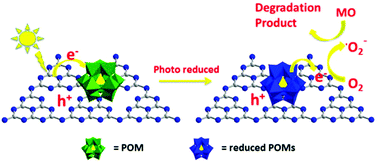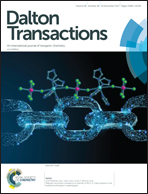Tuning of the photocatalytic performance of g-C3N4 by polyoxometalates under visible light†
Abstract
Carbon nitride (g-C3N4), as a rising star of metal-free photocatalysts, has received considerable attention. However, for practical application, the photocatalytic efficiency of g-C3N4 remains to be further improved. Herein, a series of Keggin-type polyoxoanion (polyoxoanions = SiW12O404−, PW12O403−, PMo12O403−) modified g-C3N4 (POM/C3N4) composites have been successfully prepared. The results of XRD, TEM, XPS and EDAX reveal that a small amount of polyoxoanions was modified on the surface of g-C3N4 with electrostatic and hydrogen bonding interactions. Photocatalytic experiments indicate that these composites exhibit enhanced methyl orange (MO) degradation photocatalytic activity and water splitting H2 production under visible light irradiation. The loading amount and the type of polyoxoanion can tune the photocatalytic performance of the composites. Among these catalysts, 5% SiW12O404− (SiW12)-modified g-C3N4 has the best photocatalytic performance, which is 4.4 times higher than that of pure g-C3N4 for the degradation of MO. The photocatalytic mechanism reveals that polyoxoanions can act as electron traps, which can efficiently promote the separation of photogenerated electrons and holes of C3N4, thus resulting in the enhanced photocatalytic performance of the composites.



 Please wait while we load your content...
Please wait while we load your content...